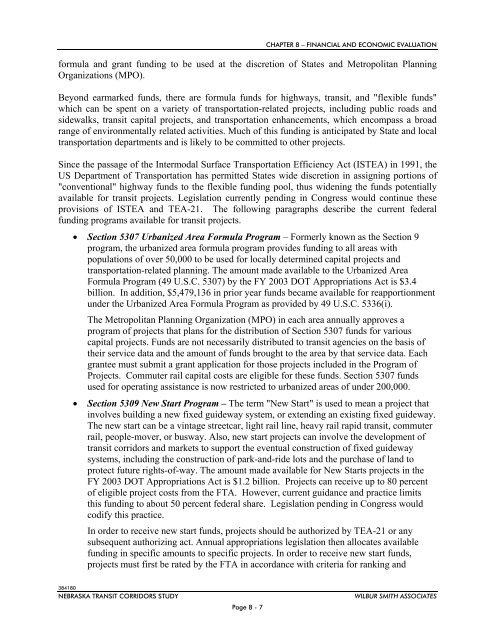NTRAC Final Study - Nebraska Department of Roads - State of ...
NTRAC Final Study - Nebraska Department of Roads - State of ...
NTRAC Final Study - Nebraska Department of Roads - State of ...
Create successful ePaper yourself
Turn your PDF publications into a flip-book with our unique Google optimized e-Paper software.
CHAPTER 8 – FINANCIAL AND ECONOMIC EVALUATION<br />
formula and grant funding to be used at the discretion <strong>of</strong> <strong>State</strong>s and Metropolitan Planning<br />
Organizations (MPO).<br />
Beyond earmarked funds, there are formula funds for highways, transit, and "flexible funds"<br />
which can be spent on a variety <strong>of</strong> transportation-related projects, including public roads and<br />
sidewalks, transit capital projects, and transportation enhancements, which encompass a broad<br />
range <strong>of</strong> environmentally related activities. Much <strong>of</strong> this funding is anticipated by <strong>State</strong> and local<br />
transportation departments and is likely to be committed to other projects.<br />
Since the passage <strong>of</strong> the Intermodal Surface Transportation Efficiency Act (ISTEA) in 1991, the<br />
US <strong>Department</strong> <strong>of</strong> Transportation has permitted <strong>State</strong>s wide discretion in assigning portions <strong>of</strong><br />
"conventional" highway funds to the flexible funding pool, thus widening the funds potentially<br />
available for transit projects. Legislation currently pending in Congress would continue these<br />
provisions <strong>of</strong> ISTEA and TEA-21. The following paragraphs describe the current federal<br />
funding programs available for transit projects.<br />
Section 5307 Urbanized Area Formula Program – Formerly known as the Section 9<br />
program, the urbanized area formula program provides funding to all areas with<br />
populations <strong>of</strong> over 50,000 to be used for locally determined capital projects and<br />
transportation-related planning. The amount made available to the Urbanized Area<br />
Formula Program (49 U.S.C. 5307) by the FY 2003 DOT Appropriations Act is $3.4<br />
billion. In addition, $5,479,136 in prior year funds became available for reapportionment<br />
under the Urbanized Area Formula Program as provided by 49 U.S.C. 5336(i).<br />
The Metropolitan Planning Organization (MPO) in each area annually approves a<br />
program <strong>of</strong> projects that plans for the distribution <strong>of</strong> Section 5307 funds for various<br />
capital projects. Funds are not necessarily distributed to transit agencies on the basis <strong>of</strong><br />
their service data and the amount <strong>of</strong> funds brought to the area by that service data. Each<br />
grantee must submit a grant application for those projects included in the Program <strong>of</strong><br />
Projects. Commuter rail capital costs are eligible for these funds. Section 5307 funds<br />
used for operating assistance is now restricted to urbanized areas <strong>of</strong> under 200,000.<br />
<br />
Section 5309 New Start Program – The term "New Start" is used to mean a project that<br />
involves building a new fixed guideway system, or extending an existing fixed guideway.<br />
The new start can be a vintage streetcar, light rail line, heavy rail rapid transit, commuter<br />
rail, people-mover, or busway. Also, new start projects can involve the development <strong>of</strong><br />
transit corridors and markets to support the eventual construction <strong>of</strong> fixed guideway<br />
systems, including the construction <strong>of</strong> park-and-ride lots and the purchase <strong>of</strong> land to<br />
protect future rights-<strong>of</strong>-way. The amount made available for New Starts projects in the<br />
FY 2003 DOT Appropriations Act is $1.2 billion. Projects can receive up to 80 percent<br />
<strong>of</strong> eligible project costs from the FTA. However, current guidance and practice limits<br />
this funding to about 50 percent federal share. Legislation pending in Congress would<br />
codify this practice.<br />
In order to receive new start funds, projects should be authorized by TEA-21 or any<br />
subsequent authorizing act. Annual appropriations legislation then allocates available<br />
funding in specific amounts to specific projects. In order to receive new start funds,<br />
projects must first be rated by the FTA in accordance with criteria for ranking and<br />
384180<br />
NEBRASKA TRANSIT CORRIDORS STUDY<br />
Page 8 - 7<br />
WILBUR SMITH ASSOCIATES

















